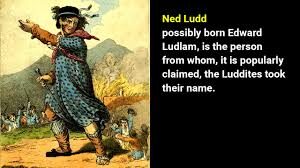Who were the Luddites, and what have they got to do with Technical Unemployment?
What relevance do a group of protesters breaking textile weaving looms in mills in the 18th Century have to do with today’s technological society?
Perhaps it is through the names people and society in general have used to describe those who are afraid of or opposed to technology, and ‘Luddite’ is one of the more frequently used.
In this blog, we will investigate the Luddites, and how the definition and the application of the word in regard to people has come about.

Discussion
In more recent times, the terms ‘Technologically Challenged’ or ‘Technophobe’ (Anon., 2020) amongst many others have replaced the word Luddite, when describing a person that is opposed to or afraid of technology and where it is used. (Conde, 2016)
This definition of Luddite is based on a set of historical events that happened in a number of Northern counties within the United Kingdom during the 18th Century.
But first let me set the scene…. The United Kingdom was at war with France and Napoleon Bonaparte and had been for a number of years.
This war was having such an impact on the British economy that poverty levels were increasing, food costs were increasing, and unemployment was at a high.
These events seem to have been the catalyst, but was the root of the protests actually the change from a home-based textile industry to a Mill (Factory) based industry?
This change – the move from Home weaving to mass produced textile productions through powered looms – had been ongoing for about 200 years, since the introduction of the powered loom in the 1600s, (Mokyr, et al., 2015).
So, we have workers, using powered looms, in order to mass produce textiles, high poverty levels, high unemployment and high food costs, and to top it all off – war, and the pressures that puts on an economy.
The combination of these factors triggered a number of protests about pay and working conditions for textile workers within owned mills, and concluded with the destruction of some power looms.
However, most of the protesters were very skilled at using the machines to create the textiles, and therefore not opposed to the use of the machines within the textile industry, so why destroy the machinery they use?
The first protest in 1811 and located at a mill in Nottingham, resulted in a set of looms being damaged, but this was also ended by the British military.
But why did the weavers protest and break the machines?
Where they anti the new technology, the machines? In fact, the weavers were protesting over the pay and the conditions they got from the mill they were protesting at (Conniff, 2011).
So, who was Led Ludd? Did he exist? Did he move around England training armies of protesters at night, (Conniff, 2011), or was he the clever creation of separate groups of protesters, who used a fictional person as a figure head.
The story goes that there was an apprentice named Ludd, or Ludham who after being admonished for creating a substandard piece of cloth, broke the machine he was working on.
The protesters, it has been suggested by historians, used this person to create a fictional leader giving him further names like the General Ludd, King Ludd.
(Binfield, 2004) in his collection of writings suggests that the protesters confined their attacks to mills that had been identified as employing labour in a fraudulent and deceitful way in order to circumvent standard labour practices and regulations.
The protesters used Ludd as a figurehead to mobilise more protesters, and poke fun at the British Government.
But as has been suggested there was no real or centralised organisation behind the protests and which mills would receive the attention of the protesters next.
These protests were not organised and were sporadic, and protests happened over a 5 year period starting from 1811 and finishing in 1816.
But as much as the protesters used violence – some killing a mill owner, another protest resulted in a mill be set on fire – the Luddites or the protesters often received more violence against them then they used.
The protests where stopped when 3 Luddites were hung for the murder of the mill owner in 1816, with approximately 20 being killed by British troops as they opened fire on the protesters at the different protests, by order of the British Government in order in to protect the mills.
In Conclusion
Was Ned Ludd real? was he an actual person, who moved between sets of protesters, organising attacks on mills, looms and mill owners?
Or was he a fictional character who was adopted and used as a symbolic leader for the protesters to rally around when protesting, making sure government and mill owners understood the concerns the workers had?
So how is the possibly fictional character named Ludd and the protests about pay and working conditions (and not about the use of technology used in the mills to produce textiles), connect with modern technological unemployment, or hostility to the implementation of technologies, within the work place?
Historians suggest that the reason ‘Luddite’ has become connected with ‘Technical Unemployment’, is due to the high unemployment rates at the time the protests occurred, partly due (over 200 years) to the change from home weaving to mill based mass textile production, the war with France, high food prices, and the challenging economic situation.
So, to answer the questions asked in the introduction; ‘who were the Luddites?’ Most were a set of skilled textile workers adept at using the machines that mass-produced textiles, who broke some machines whilst protesting about pay and working conditions, and not about the use of the machines themselves.
The second question; ‘what have they to do with Technical Unemployment?’
I would suggest nothing at all!
What are your thoughts, are the protests and the situation the protests were made in relevant today? Is technological Unemployment a real thing? Have you been made unemployed by a computer?
Bibliography
Anon., 2020. Meaning of Technophobe. [Online]
Available at: https://dictionary.cambridge.org/us/dictionary/english/technophobe?q=Technophobe
Binfield, K., 2004. Writting of the Luddites. 1 ed. Baltamore: Johns Hopkins University Press.
Conde, A., 2016. Luddites: 200 Years of Technology Innovation. [Online]
Available at: https://insh.world/culture/luddites/
[Accessed 8 Jan 2020].
Conniff, R., 2011. What the Luddites Really Fought Against. Smithsonian Magazine, 1 March, p. 4.
Mokyr, J., Vickers, C. & Ziebarth, N. L., 2015. The History of Technological Anxiety and the Future of Economic Growth: Is it different this time. Journal of Economic Perspectives, 29(3), pp. 31 – 50.
Next Blog
The Debate between Elon Musk and Bill Gates about the ultimate effects of Technological Unemployment




